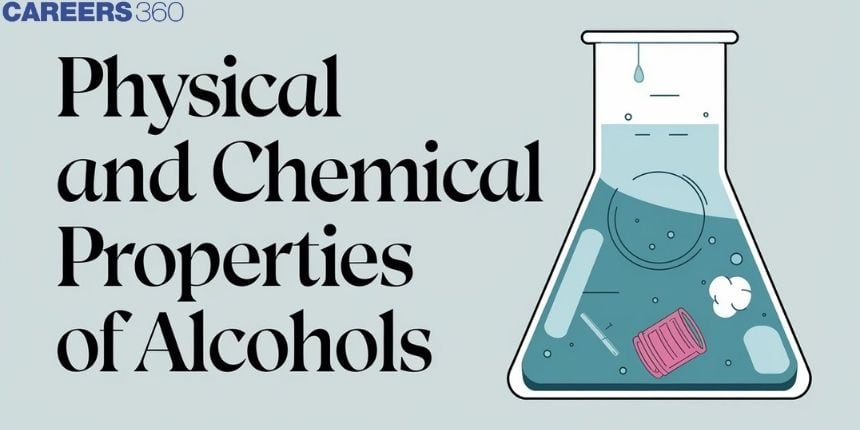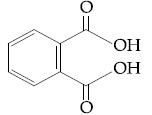Physical and Chemical Properties of Alcohols
Alcohols, with one or more hydroxide (-OH) groups, participate in the requirements sensed of the most fundamental life and, simultaneously, explained. The issue of ethanol as a beverage is associated with the isopropyl alcohol in hand sanitizers. The importance of alcohols for synthetic chemistry and everyday products is secured because of the diversity in their physical and chemical application features that they can offer and represent in very many fields.
This Story also Contains
- Physical and Chemical Properties of Alcohols
- Chemical Reactions of Alcohols
- Significance and Application
- Some Solved Examples
- Summary

Their physical properties are dominated by the peculiar hydrogen bonding and differ much from the typical organic compounds in behavior; chemically, alcohols have a whole spectrum of reactivities involving changes in them to other valuable compounds. This module will address both the physical and chemical properties of alcohols, pointing out selected reactions that establish their functionality. Views on the acylation and oxidation reactions of alcohols towards the preparation of esters, aldehydes, ketones, and carboxylic acids will be considered.
Physical and Chemical Properties of Alcohols
Alcohols belong to a class of organic compounds containing one or more hydroxyl (-OH) groups directly linked to a carbon atom. They can be classified as primary, secondary, and tertiary alcohol, relative to how many carbon atoms are bonded directly to the hydroxyl-bearing carbon. Physically, alcohols have higher boiling and melting points than alkanes and alkenes of similar molecular weight due to the presence of a strong hydrogen bond among them. This hydrogen bonding also contributes to their high water solubility.Alcohols are chemical entities whose reactivity in the molecule is ensured by the polar nature of the hydroxyl functional group. One of the sequences of reactions that alcohols undergo includes acylation, whereby an acyl group is introduced into the molecule, and oxidation, whereby alcohol is oxidized into aldehydes, ketones, or carboxylic acids. Such reactions are of paramount importance to the field and industry of organic synthesis. The alcohols can also be esterified, a reaction with acids that gives rise to esters, or be more or less oxidized into carboxylic acids or reduced into alkanes.
Lower members of alcohols are colorless liquids whereas higher members are colourless solids.
- Alcohols have higher boiling points.
- The boiling point of alcohols increases with an increase in members of the OH group.
- Lower members are highly soluble in water.
Chemical Reactions of Alcohols
1. Acylation and Oxidation of Alcohols:
Acylation is the reaction of the bonding of an acyl group ((CH3)C=0) to the alcohol that produces esters. The reaction has great utility in the preparation of perfumes and a wide range of pharmaceuticals also. The oxidation of alcohol depends upon the molecular form. Primary alcohols can easily be oxidized to aldehydes, which are easily oxidized to carboxylic acids. Oxidation of secondary alcohols leads to the formation of ketones, and even this property is greatly utilized in the synthesis of a huge amount of organic matter.
Acylation of alcohols
Ethanoyl chloride reacts instantly with cold ethanol. There is a very exothermic reaction in which a steamy acidic gas is given off (hydrogen chloride) and ethyl ethanoate (an ester) is formed.
For example,

Oxidation of Alcohols
The nature of the oxidation products depends on whether the alcohol is primary, secondary, or tertiary. The oxidizing agents usually employed are acidified potassium dichromate, acidified or alkaline potassium permanganate, or dilute nitric acid. It is a test of different alcohols as primary, secondary, and tertiary alcohols give different products during oxidation.
- Primary alcohols give acids having the same number of carbon atoms with acidic $\mathrm{KMnO}_4$ or $\mathrm{K}_2 \mathrm{Cr}_2 \mathrm{O}_7$. For example,$\mathrm{CH}_3 \mathrm{CH}_2 \mathrm{OH} \xrightarrow[-\mathrm{H}_2 \mathrm{O}]{[\mathrm{O}] \text { acidic } \mathrm{KMnO}_4} \mathrm{CH}_3-\mathrm{CHO} \xrightarrow{[\mathrm{O}] \text { acidic } \mathrm{KMnO}_4} \underset{\text { Acetic acid }}{\mathrm{CH}_3 \mathrm{COOH}}$
- Secondary alcohol on oxidation gives ketone which undergoes further oxidation under drastic conditions by strong oxidizing agents like HNO3 to give acid with one carbon atom less than the alcohol. For example,$\left(\mathrm{CH}_3\right)_2-\mathrm{CHOH} \xrightarrow[\mathrm{K}_2 \mathrm{Cr}_2 \mathrm{O}_7 / \mathrm{Cr}_2 \mathrm{O}_3]{\mathrm{Gla} \mathrm{CH}_3 \mathrm{COOH}[\mathrm{O}]} \mathrm{CH}_3-\mathrm{CO}-\mathrm{CH}_3 \longrightarrow \mathrm{CH}_3 \mathrm{COOH}+\mathrm{CO}_2+\mathrm{H}_2 \mathrm{O}$
- Tertiary alcohol cannot undergo oxidation by mild oxidizing agents as above however it can be oxidized under drastic conditions by strong oxidizing agents and the final product acid will have two carbon atoms less than alcohol.


2. Haloform Reaction:
The oxidation of methyl ketones into carboxylic acids is attended by the subsequent formation of a haloform compound whereby X represents a halogen. More often than not, it is a useful test for the identification of methyl ketones. This test, too, has undergone greater practical use because of its usefulness in organic synthesis and analytical chemistry.
Ethyl alcohol when heated with iodine and sodium hydroxide or aqueous sodium carbonate forms a yellow crystalline solid, iodoform. The reaction occurs as follows:
$\mathrm{C}_2 \mathrm{H}_5 \mathrm{OH}+4 \mathrm{I}_2+6 \mathrm{NaOH} \xrightarrow{\text { Heat }} \mathrm{CHI}_3+5 \mathrm{NaI}+\mathrm{HCOONa}+5 \mathrm{H}_2 \mathrm{C}$
Methyl alcohol does not respond to the iodoform test. In place of iodine, bromine or chlorine can be taken when the corresponding compounds bromoform or chloroform are to be formed. The reaction in general is known as haloform reaction.
3. Pinacol-Pinacolone Rearrangement:
This acid-catalyzed rearrangement of Pinacol, a diol, results in the formation of Pinacolone. The reaction demonstrates the migration of carbon skeletons in a diol. The rearrangement reaction is used in the synthesis of ketones from diols. It also explains how the alcohols can be transformed into useful compounds with a simple rearrangement.
The pinacol rearrangement is the acid-catalyzed dehydration of glycols, which converts the glycol into an aldehyde or a ketone. When pinacols are treated with mineral acids, acid chlorides, $\mathrm{ZnCl}_2$ or another electrophilic reagent, they rearrange to form ketones called pinacolones with the elimination of$\mathrm{H}_2 \mathrm{O}$.
Mechanism

For example

NOTE: With unsymmetrical glycols, the product obtained is determined mainly by the OH that is lost as $\mathrm{H}_2 \mathrm{O}$to give more stable carbocation and thereafter by the better migrating group.
4. Oxidative Cleavage with HIO4:
Periodic acid, HIO4, is employed in the oxidative cleavage of diols into aldehydes or ketones. This reaction is very central in determining the structure of organic molecules and enjoys widespread applications in synthesis for the cleavage of diol structures and learning about molecular architecture for complex compounds.
At least $2-\mathrm{OH}$ or $2>\mathrm{C}=\mathrm{O}$ or $1-\mathrm{OH}$ and $1>\mathrm{C}=\mathrm{O}$ should be at adjacent carbons. $\mathrm{HIO}_4$ works as an oxidising agent here.
Some examples include,


Significance and Application
General physicochemical knowledge related to alcohols is very important for both academic studies and practical applications. Alcohols are known to be good solvents and also act as pharmaceutical intermediates for drug synthesis. A variety of medicinally important compounds can be formed from alcohols through oxidation and acylation reactions. Ethanol as a solvent and reactant in drug synthesis, and oxidation of alcohols, gives important pharmaceutical intermediates.
The ability to identify and purify compounds resulting from industrial chemical reactions, such as the haloform reaction, allows the quality of products related to industrial chemistry to be determined. This rearrangement is found in the application of pinacol-pinacolone, thus notating practical novelty for transformations of alcohols. Periodic acid oxidative cleavage is applicable in research for the elucidation of structures of complex organic molecules that could be used in developing new materials and compounds.
The physical properties, like boiling points and solubility, are directly involved in the designing of the chemical process and optimal conditions. For applied and synthetic chemistry, due to their potential conversion into a great number of compounds from the majority of chemical classes using various chemical transformations, alcohols acquire extreme importance and therefore become irreplaceable in huge scientific and industrial spheres.
Recommended topic video on(Physical and Chemical Properties of Alcohols)
Some Solved Examples
Example 1
Question:
Consider the hydroxyl derivatives of benzene given below:
I. 1,2-Dihydroxybenzene
II. 1,3-Dihydroxybenzene
III. 1,4-Dihydroxybenzene
IV. Hydroxybenzene
What is the increasing order of boiling points of the above-mentioned alcohols?
Solution:
To determine the increasing order of boiling points, consider the hydrogen bonding in each compound. Hydroxybenzene has the lowest boiling point due to having only one hydroxyl group. 1,2-dihydroxybenzene has intramolecular hydrogen bonding, resulting in a lower boiling point than 1,3- and 1,4-dihydroxybenzenes, which have stronger intermolecular hydrogen bonding. Among the dihydroxybenzenes, 1,4-Dihydroxybenzene has the highest boiling point because it forms strong intermolecular hydrogen bonds.
Thus, the increasing order of boiling points is:
IV < I < II < III
Example 2
Question:
Among the following four aromatic compounds, which one will have the lowest melting point?
1) Naphthalene
2) Benzene
3) Toluene
4) Xylenes
Solution:
To determine the lowest melting point, consider the nature of intermolecular forces in each compound. Naphthalene has weaker intermolecular interactions compared to benzene, toluene, and xylenes, which have stronger Van der Waals forces due to their larger size and the presence of additional methyl groups.
Therefore, Naphthalene, which does not exhibit hydrogen bonding and has lower intermolecular forces, will have the lowest melting point.
Example 3
Question:
Among the following four aromatic compounds, which one will have the lowest melting point ?
1)
2)
3)
4) (correct)
Solution:
As we have learned about the melting point, the force of attraction between the molecules affects the MP of a compound. stronger intermolecular interactions will result in higher M.P.
Naphthalene has no hydrogen bonding.
The melting point of Naphthalene is near about 80ºC.
Therefore, option(4) is correct.
Summary
Alcohols represent one of the most heterogeneous classes of organic compounds, showing a range of important physical and chemical properties. Due to their nature, resulting in a high boiling point value caused by hydrogen bonding, and the reactivity towards many chemical transformations, make them very important, not only in everyday products but also in industrial processes. Key reactions for their application in chemical syntheses or analysis will include acylation, oxidation, haloform reaction, pinacol-pinacolone rearrangement, and oxidative cleavage with periodic acid.



